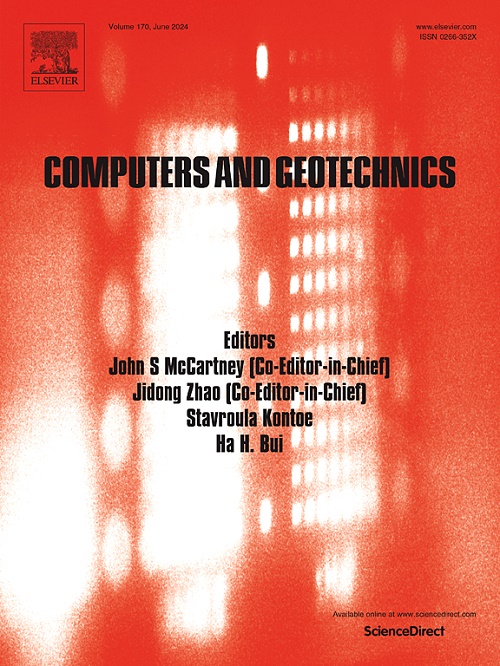考虑堆石坝空间变异性的基于ngboost的堆石坝沉降概率代理模型
IF 6.2
1区 工程技术
Q1 COMPUTER SCIENCE, INTERDISCIPLINARY APPLICATIONS
引用次数: 0
摘要
基于传统蒙特卡罗随机有限元分析的堆石料空间变异性识别计算量较大。另一种方法是建立一个有效的替代模型,在给定的堆石料空间变异性下准确地估计概率堆石坝沉降(RDS)。为此,提出了一种概率代理建模方法,对概率RDS进行高效、有效的均值预测和不确定性量化。该方法首先通过全局敏感性分析,考虑堆石料分区的共同作用,确定影响堆石料参数的关键参数,然后利用多参数、多区域互关联随机场对其进行表征。随后,采用NGBoost (Natural Gradient Boosting)算法进行概率代理建模,建立堆石料参数与坝体沉降概率分布的映射关系。为了增强基于ngboost的代理模型,提出了一种预测区间优化(PIO)驱动的超参数调优方法,该方法以高于目标的预测区间概率覆盖率(PICP)和最小预测区间平均相对宽度(PIARW)为优化目标。然后,利用SHapley加性解释(SHAP)方法进行模型解释,进一步验证模型的有效性。可解释的PIO-NGBoost模型的实现在实际的堆石坝上进行了演示。结果表明,PIO-NGBoost模型能够同时进行准确的均值预测和有效的不确定性估计,与其他常用的概率模型相比,表现出更满意的性能。此外,该模型在不同堆石料空间变异性配置下仍然有效,且具有较高的计算效率。该研究为以较低的计算成本实现概率代理建模的优异性能提供了一种先进的方法。本文章由计算机程序翻译,如有差异,请以英文原文为准。
NGBoost-based probabilistic surrogate modeling for rockfill dam settlements considering rockfill spatial variability
Rockfill spatial variability identification based on conventional Monte-Carlo stochastic finite element analysis can be computationally intensive. An alternative approach is to construct an efficient surrogate model that can accurately estimate the probabilistic rockfill dam settlement (RDS) under specified rockfill spatial variability. In light of this, a probabilistic surrogate modeling method is proposed for efficient and effective mean prediction and uncertainty quantification of the probabilistic RDS. In this methodology, the key influencing rockfill material parameters are firstly identified considering the joint effect of rockfill subzones by global sensitivity analysis, which are subsequently characterized using a cross-correlated multi-parameter and multi-zone random field. Afterwards, Natural Gradient Boosting (NGBoost) algorithm is adopted for probabilistic surrogate modeling to establish the mapping relationship between rockfill material parameters and dam settlement probabilistic distribution. A novel prediction interval optimization (PIO)-driven hyperparameter tuning method is developed to enhance the NGBoost-based surrogate model, which takes an above-target prediction interval probability coverage (PICP) and a minimal prediction interval average relative width (PIARW) as optimization objectives. Then, model interpretation using SHapley Additive exPlanation (SHAP) method is conducted to further validate the model effectiveness. The implementation of the interpretable PIO-NGBoost model is demonstrated on a real-world rockfill dam. The results indicate that the PIO-NGBoost model can produce accurate mean prediction and effective uncertainty estimation simultaneously, and exhibits more satisfactory performance compared with other commonly used probabilistic models. Besides, the proposed model can still be effective under different rockfill spatial variability configurations with superior computational efficiency. This study provides an advanced means to achieve excellent performance in probabilistic surrogate modeling at a low computation cost.
求助全文
通过发布文献求助,成功后即可免费获取论文全文。
去求助
来源期刊

Computers and Geotechnics
地学-地球科学综合
CiteScore
9.10
自引率
15.10%
发文量
438
审稿时长
45 days
期刊介绍:
The use of computers is firmly established in geotechnical engineering and continues to grow rapidly in both engineering practice and academe. The development of advanced numerical techniques and constitutive modeling, in conjunction with rapid developments in computer hardware, enables problems to be tackled that were unthinkable even a few years ago. Computers and Geotechnics provides an up-to-date reference for engineers and researchers engaged in computer aided analysis and research in geotechnical engineering. The journal is intended for an expeditious dissemination of advanced computer applications across a broad range of geotechnical topics. Contributions on advances in numerical algorithms, computer implementation of new constitutive models and probabilistic methods are especially encouraged.
 求助内容:
求助内容: 应助结果提醒方式:
应助结果提醒方式:


